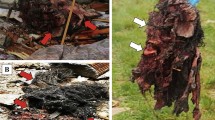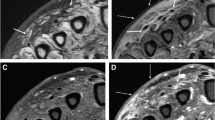Abstract
Victims of violent crime often have evidence of sharp force trauma (SFT) which needs to be examined to accurately investigate these cases. The abilities of CTs, X-rays, and Lodox to detect skeletal SFT defects and the minimum number of impacts were assessed, as were their abilities to macroscopically interpret SFT with the aim of identifying the class of weapon used. Ten pigs were, post-mortem, stabbed using a kitchen knife on one side of the body and chopped using a panga on the other side. They were then scanned and macerated. The number of SFT defects, type of SFT, and minimum number of impacts identifiable osteologically were recorded, as well as when using each imaging modality. CTs were most sensitive for detecting stab and chop defects (56.7% and 78.3%, respectively) and the minimum number of impacts (82.8%), while X-rays were least sensitive (17.2% for stab wounds, 46.5% for chop marks, and 43.5% for impacts). Lodox detected 26.8% of stab defects, 59.3% of chop marks, and 58.4% of impacts. The type of SFT for more than 70.0% of identified defects was correctly classified using all methods, while only Lodox had moderate sensitivities for stab wounds (52.4%). When radiological assessments of skeletal SFT are required, CTs should be performed, but Lodox can be used as an alternative. However, dry bone analyses still produce the best results and should be performed whenever possible. Macroscopic interpretations of skeletal SFT to broadly determine the class of weapon used is possible radiologically.








Similar content being viewed by others
Data availability
Available upon request.
References
Scientific Working Group of Anthropology (SWGANTH) (2011) Trauma analysis. https://www.nist.gov/system/files/documents/2018/03/13/swganth_trauma.pdf. Accessed 3 February 2021.
İşcan MY, Steyn M (2013) The human skeleton in forensic medicine, 3rd edn. Charles C Thomas Publisher Ltd., Illinois
South African Police Services (2020) Crime statistics: April 2019-March 2020. https://www.saps.gov.za/services/april_to_march_2019_20_presentation.pdf. Accessed 3 February 2021.
Saimen A, Guinevere G, Govender I (2016) Non-fatal injuries of interpersonal violence at the Leratong Provincial Hospital. South Africa S Afr Fam Pract 58(3):80–86. https://doi.org/10.1080/20786190.2016.1167311
Nicol A, Knowlton LM, Schuurman N, Matzopoulos R, Zargaran E, Cinnamon J, Fawcett V, Taulu T, Hameed M (2014) Trauma surveillance in Cape Town, South Africa: An analysis of 9236 consecutive trauma center admissions. JAMA Surg 149(6):549–556. https://doi.org/10.1001/jamasurg.2013.5267
Symes SA, L’Abbé EN, Chapman EN, Wolff I, Dirkmaat DC (2012) Interpreting traumatic injury to bone in medicolegal investigations. In: Dirkmaat DC (ed) A companion to forensic anthropology. John Wiley & Sons, Chichester, pp. 340–389. https://doi.org/10.1002/9781118255377.ch17
Ferllini R (2012) Macroscopic and microscopic analysis of knife stab wounds on fleshed and clothed ribs. J Forensic Sci 57(3):683–690. https://doi.org/10.1111/j.1556-4029.2012.02087.x
Humphrey JH, Hutchinson DL (2001) Macroscopic characteristics of hacking trauma. J Forensic Sci 46(2):228–233. https://doi.org/10.1520/JFS14954J
Lynn KS, Fairgrieve SI (2009) Macroscopic analysis of axe and hatchet trauma in fleshed and defleshed mammalian long bones. J Forensic Sci 54(4):786–792. https://doi.org/10.1111/j.1556-4029.2009.01061.x
Symes SA, Chapman EN, Rainwater CW, Cabo LL, Myster SMT (2010) Knife and saw toolmark analysis in bone: a manual designed for the examination of criminal mutilation and dismemberment, NIJ. https://www.ojp.gov/pdffiles1/nij/grants/232864.pdf. Accessed 8 February 2021.
Martlin B, Rando C (2021) An assessment of the reliability of cut surface characteristics to distinguish between hand-powered reciprocating saw blades in cases of experimental dismemberment. J Forensic Sci 66(2):444–455. https://doi.org/10.1111/1556-4029.14628
Dedouit F, Telmon N, Costagliola R, Otal P, Joffre F, Rougé D (2007) Virtual anthropology and forensic identification: report of one case. Forensic Sci Int 173(2–3):182–187. https://doi.org/10.1016/j.forsciint.2007.01.002
Coty J-B, Nedelcu C, Yahya S, Dupont V, Rougé-Maillart C, Verschoore M, Ridereau Zins C, Aubé C (2018) Burned bodies: post-mortem computed tomography, an essential tool for modern forensic medicine. Insights Imaging 9:731–743. https://doi.org/10.1007/s13244-018-0633-2
Bauer M, Patzelt D (2002) Intracranial stab injuries: case report and case study. Forensic Sci Int 129:122–127. https://doi.org/10.1016/S0379-0738(02)00271-2
Schnider J, Thali MJ, Ross S, Oesterhelweg L, Spendlove D, Bolliger SA (2009) Injuries due to sharp trauma detected by post-mortem multislice computed tomography (MSCT): A feasibility study. Legal Med 11:4–9. https://doi.org/10.1016/j.legalmed.2008.07.001
Thomsen AH, Jurik AG, Uhrenholt L, Vesterby A (2009) An alternative approach to computerized tomography (CT) in forensic pathology. Forensic Sci Int 183:87–90. https://doi.org/10.1016/j.forsciint.2008.10.019
Kawasumi Y, Hosokai Y, Usui A, Saito H, Ishibashi T, Funayama M (2012) Postmortem computed tomography images of a broken piece of a weapon in the skull. Jpn J Radiol 30:167–170. https://doi.org/10.1007/s11604-011-0018-7
Zerbini T, Silva LF, Ferro AC, Kay FU, Amaro Junior A, Pasqualucci CA, Saldiva PH (2014) Differences between postmortem computed tomography and conventional autopsy in a stabbing murder case. Clinics (Sao Paulo) 69(10):683–687. https://doi.org/10.6061/clinics/2014(10)06
Uzunosmanoğlu H, Çorbacioğlu SK, Çevik Y, Akinci E, Hacifazlioğlu Ç, Yavuz A, Yüzbasioğlu Y (2017) What is the diagnostic value of computed tomography tractography in patients with abdominal stab wounds? Eur J Trauma Emerg Surg 43:273–277. https://doi.org/10.1007/s00068-015-0625-6
Thali MJ, Taubenreuther U, Karolczak M, Braun M, Brueschweiler W, Kalender WA, Dirnhofer R (2003) Forensic microradiology: micro-computed tomography (Micro-CT) and analysis of patterned injuries inside of bone. J Forensic Sci 48(6):1336–1342. https://doi.org/10.1520/JFS2002220
Gaudio D, Di Giancamillo M, Gibelli D, Galassi A, Cerutti E, Cattaneo C (2014) Does cone beam CT actually ameliorate stab wound analysis in bone? Int J Legal Med 128:151–159. https://doi.org/10.1007/s00414-013-0820-0
Pelletti G, Viel G, Fais P, Viero A, Visentin S, Miotto D, Montisci M, Cecchetto G, Giraudo C (2017) Micro-computed tomography of false starts produced on bone by different hand-saws. Legal Med 26:1–5. https://doi.org/10.1016/j.legalmed.2017.01.009
Komo L, Grassberger M (2018) Experimental sharp force injuries to ribs: Multimodal morphological and geometric morphometric analyses using micro-CT, macro photography and SEM. Forensic Sci Int 288:189–200. https://doi.org/10.1016/j.forsciint.2018.04.048
Norman DG, Watson DG, Burnett B, Fenne PM, Williams MA (2018) The cutting edge – micro-CT for quantitative toolmark analysis of sharp force trauma to bone. Forensic Sci Int 283:156–172. https://doi.org/10.1016/j.forsciint.2017.12.039
Ampanozi G, Ruder TD, Preiss U, Aschenbroich K, Germerott T, Filograna L, Thali MJ (2010) Virtopsy: CT and MR imaging of a fatal head injury caused by a hatchet: A case report. Legal Med 12:238–241. https://doi.org/10.1016/j.legalmed.2010.04.004
Johnson CP, Melmore SA, Johnson O, Campbell RSD, Dunn A (2014) Life threatening chop injuries to the head: Optimising injury interpretation using three dimensional computerised tomography (3DCT) reconstruction of pre-treatment imaging. J Forensic Legal Med 28:1–4. https://doi.org/10.1016/j.jflm.2014.09.005
Wittschieber D, Beck L, Vieth V, Hahnemann ML (2016) The role of 3DCT for the evaluation of chop injuries in clinical forensic medicine. Forensic Sci Int 266:e59–e63. https://doi.org/10.1016/j.forsciint.2016.05.025
Boffard KD, Goosen J, Plani F, Degiannis E, Potgieter H (2006) The use of low-dosage X-ray (Lodox/Statscan) in major trauma: comparison between low dose X-ray and conventional X-ray techniques. J Trauma 60(6):1175–1183. https://doi.org/10.1097/01.ta.0000220393.26629.6c
Whiley SP, Alves H, Grace S (2013) Full-body X-ray imaging to facilitate triage: a potential aid in high-volume emergency departments. Emerg Med Int 43:70–78. https://doi.org/10.1155/2013/437078
du Plessis M, Date-Chong M, Liebenberg L (2020) Lodox®: the invaluable radiographic solution in the forensic setting. Int J Legal Med 134:655–662. https://doi.org/10.1007/s00414-019-02116-y
Waltenberger L, Beitel S, Bernegger B, Heimel P, Weninger W, Kanz F (2021) A histological comparison of non-human rib models suited for sharp force trauma analysis. Forensic Sci Int 319:110661. https://doi.org/10.1016/j.forsciint.2020.110661
Shelmerdine SC, Langan D, Hutchinson JC, Hickson M, Pawley K, Suich J, Palm L, Sebire NJ, Wade A, Arthurs OJ (2018) Chest radiographs versus CT for the detection of rib fractures in children (DRIFT): a diagnostic accuracy observational study. Lancet Child Adolesc Health 2:802–811. https://doi.org/10.1016/S2352-4642(18)30274-8
Spies AJ, Steyn M, Brits D (2022) Diagnostic accuracies of CTs, X-rays and Lodox to detect blunt force trauma in adults, using a pig model. Med Sci Law 62(2):134–143. https://doi.org/10.1177/00258024211049591
Landis JR, Koch GG (1977) The measurement of observer agreement for categorical data. Biometrics 33(1):159–174. https://doi.org/10.2307/2529310
Chevallier C, Doenz F, Vaucher P, Palmiere C, Dominguez A, Binaghi S, Mangin P, Grabherr S (2013) Postmortem computed tomography angiography vs conventional autopsy: advantages and inconveniences of each method. Int J Legal Med 127(5):981–989. https://doi.org/10.1007/s00414-012-0814-3
Cattaneo C, Marinelli E, Di Giancamillo A, Di Giancamillo M, Travetti O, Vigano L, Poppa P, Porta D, Gentilomo A, Grandi M (2006) Sensitivity of autopsy and radiological examination in detecting bone fractures in an animal model: implications for the assessment of fatal child physical abuse. Forensic Sci Int 164(2–3):131–137. https://doi.org/10.1016/j.forsciint.2005.12.016
Garvin HM, Stock MK (2016) The utility of advanced imaging in forensic anthropology. Acad Forensic Pathol 6(3):499–516. https://doi.org/10.23907/2016.050
Kooi RJ, Fairgrieve SI (2013) SEM and stereomicroscopic analysis of cut marks in fresh and burned bone. J Forensic Sci 58(2):452–458. https://doi.org/10.1111/1556-4029.12050
Ong B-B (1999) The pattern of homicidal slash/chop injuries: a 10 year retrospective study in University Hospital Kuala Lumpur. J Clin Forensic Med 6(1):24–29. https://doi.org/10.1016/s1353-1131(99)90172-4
Oesterhelweg L, Ross S, Spendlove D, Schoen CA, Christe A, Thali MJ, Bolliger SA (2007) Virtopsy: Fatal stab wounds to the skull – the relevance of ante-mortem and post-mortem radiological data in case reconstructions. Legal Med 9:314–317. https://doi.org/10.1016/j.legalmed.2007.04.006
Karadağ Ö, Gürelik M, Berkan Ö, Kars HZ (2004) Stab wound of the cervical spinal cord and ipsilateral vertebral artery injury. Brit J Neurosurg 18(5):545–547. https://doi.org/10.1080/02688690400012590
Kimmerle EH, Baraybar JP (2008) Skeletal trauma: Identification of injuries resulting from human rights abuse and armed conflict. CRC Press, New York. https://doi.org/10.1016/j.scijus.2009.01.006
Ross A, Cunha E (2018) Dismemberments: Perspectives in forensic anthropology and legal medicine, 1st edn. Academic Press
Gentile S, Kneubuehl BP, Barrera V, Dobay A, Thali MJ, Bolliger SA (2019) Fracture energy threshold in parry injuries due to sharp and blunt force. Int J Legal Med 133:1429–1435. https://doi.org/10.1007/s00414-019-02022-3
Acknowledgements
We acknowledge the assistance of GHB Farms Pty (Ltd.) in Bronkhorstspruit, South Africa, for donating the pig carcasses. The authors thank Ms. Rammekwa from the Central Animal Services at the University of the Witwatersrand for taking the X-rays; Dr. Haagensen and Mrs. Bussy from the Department of Radiology at Wits Donald Gordon Medical Centre for assisting with the CT scanning; and Ms. Reindorp from the Johannesburg Forensic Pathology Services for taking the Lodox scans. We also acknowledge the assistance of Ms Nkosi from Lodox® Systems (Pty) Ltd. for training pertaining to the analysis and interpretation of Lodox scans and to Mr. Matjila, Ms. Loubser, and Ms. Landsman from the School of Anatomical Sciences at the University of the Witwatersrand for assisting with the maceration of the pig carcasses. This research was made possible in part by a grant from the JJJ Smieszek Fellowship. This work is based on the research supported in part by the National Research Foundation (NRF) of South Africa (Grant number: 118149) and the NRF/Deutscher Akademischer Austausch Dienst (DAAD) (Grant number: 117943). Opinions, findings, and conclusions or recommendations expressed are those of the authors and are not necessarily to be attributed to the NRF or DAAD.
Funding
Funding for this research was provided by the JJJ Smieszek Fellowship, National Research Foundation (NRF) and Deutscher Akademischer Austausch Dienst (DAAD). These funding sources however did not have any involvement in study design, collection, analysis and interpretation of data, writing of the report, or in the decision to submit the article for publication.
Author information
Authors and Affiliations
Contributions
AJ Spies, M Steyn, and D Brits contributed to the study’s conception and design. Material preparation and data analysis were performed by AJ Spies. Data collection was performed by AJ Spies and DN Prince. The first draft of the manuscript was written by AJ Spies, and all authors commented on all subsequent versions of the manuscript. Funding was provided in part by M Steyn and D Brits. The authors read and approved the final manuscript.
Corresponding author
Ethics declarations
Ethics approval
Permission was obtained from the Animal Research Ethics Committee (AREC) at the University of the Witwatersrand (Ethics Clearance Certificate No. 2019/04/27/O), as well as from the South African Department of Agriculture, Forestry and Fisheries (DAFF).
Consent to participate
Not applicable.
Consent for publication
Not applicable.
Code availability
Not applicable.
Conflicts of interest
The authors declare that they have no conflict of interest.
Additional information
Publisher's note
Springer Nature remains neutral with regard to jurisdictional claims in published maps and institutional affiliations.
Rights and permissions
About this article
Cite this article
Spies, A.J., Steyn, M., Prince, D.N. et al. Radiological detection of sharp force skeletal trauma: an evaluation of the sensitivity of Lodox in comparison to CT and X-ray. Int J Legal Med 136, 1417–1430 (2022). https://doi.org/10.1007/s00414-022-02845-7
Received:
Accepted:
Published:
Issue Date:
DOI: https://doi.org/10.1007/s00414-022-02845-7




